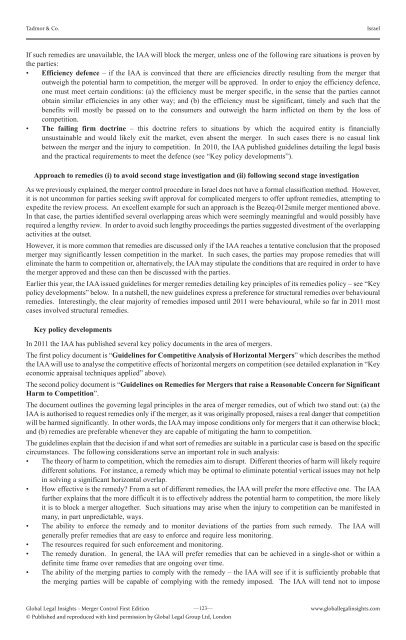Merger Controls First Edition - J Sagar Associates
Merger Controls First Edition - J Sagar Associates
Merger Controls First Edition - J Sagar Associates
Create successful ePaper yourself
Turn your PDF publications into a flip-book with our unique Google optimized e-Paper software.
Tadmor & Co. Israel<br />
If such remedies are unavailable, the IAA will block the merger, unless one of the following rare situations is proven by<br />
the parties:<br />
• Efficiency defence – if the IAA is convinced that there are efficiencies directly resulting from the merger that<br />
outweigh the potential harm to competition, the merger will be approved. In order to enjoy the efficiency defence,<br />
one must meet certain conditions: (a) the efficiency must be merger specific, in the sense that the parties cannot<br />
obtain similar efficiencies in any other way; and (b) the efficiency must be significant, timely and such that the<br />
benefits will mostly be passed on to the consumers and outweigh the harm inflicted on them by the loss of<br />
competition.<br />
• The failing firm doctrine – this doctrine refers to situations by which the acquired entity is financially<br />
unsustainable and would likely exit the market, even absent the merger. In such cases there is no casual link<br />
between the merger and the injury to competition. In 2010, the IAA published guidelines detailing the legal basis<br />
and the practical requirements to meet the defence (see “Key policy developments”).<br />
Approach to remedies (i) to avoid second stage investigation and (ii) following second stage investigation<br />
As we previously explained, the merger control procedure in Israel does not have a formal classification method. However,<br />
it is not uncommon for parties seeking swift approval for complicated mergers to offer upfront remedies, attempting to<br />
expedite the review process. An excellent example for such an approach is the Bezeq-012smile merger mentioned above.<br />
In that case, the parties identified several overlapping areas which were seemingly meaningful and would possibly have<br />
required a lengthy review. In order to avoid such lengthy proceedings the parties suggested divestment of the overlapping<br />
activities at the outset.<br />
However, it is more common that remedies are discussed only if the IAA reaches a tentative conclusion that the proposed<br />
merger may significantly lessen competition in the market. In such cases, the parties may propose remedies that will<br />
eliminate the harm to competition or, alternatively, the IAA may stipulate the conditions that are required in order to have<br />
the merger approved and these can then be discussed with the parties.<br />
Earlier this year, the IAA issued guidelines for merger remedies detailing key principles of its remedies policy – see “Key<br />
policy developments” below. In a nutshell, the new guidelines express a preference for structural remedies over behavioural<br />
remedies. Interestingly, the clear majority of remedies imposed until 2011 were behavioural, while so far in 2011 most<br />
cases involved structural remedies.<br />
Key policy developments<br />
In 2011 the IAA has published several key policy documents in the area of mergers.<br />
The first policy document is “Guidelines for Competitive Analysis of Horizontal <strong>Merger</strong>s” which describes the method<br />
the IAA will use to analyse the competitive effects of horizontal mergers on competition (see detailed explanation in “Key<br />
economic appraisal techniques applied” above).<br />
The second policy document is “Guidelines on Remedies for <strong>Merger</strong>s that raise a Reasonable Concern for Significant<br />
Harm to Competition”.<br />
The document outlines the governing legal principles in the area of merger remedies, out of which two stand out: (a) the<br />
IAA is authorised to request remedies only if the merger, as it was originally proposed, raises a real danger that competition<br />
will be harmed significantly. In other words, the IAA may impose conditions only for mergers that it can otherwise block;<br />
and (b) remedies are preferable whenever they are capable of mitigating the harm to competition.<br />
The guidelines explain that the decision if and what sort of remedies are suitable in a particular case is based on the specific<br />
circumstances. The following considerations serve an important role in such analysis:<br />
• The theory of harm to competition, which the remedies aim to disrupt. Different theories of harm will likely require<br />
different solutions. For instance, a remedy which may be optimal to eliminate potential vertical issues may not help<br />
in solving a significant horizontal overlap.<br />
• How effective is the remedy? From a set of different remedies, the IAA will prefer the more effective one. The IAA<br />
further explains that the more difficult it is to effectively address the potential harm to competition, the more likely<br />
it is to block a merger altogether. Such situations may arise when the injury to competition can be manifested in<br />
many, in part unpredictable, ways.<br />
• The ability to enforce the remedy and to monitor deviations of the parties from such remedy. The IAA will<br />
generally prefer remedies that are easy to enforce and require less monitoring.<br />
• The resources required for such enforcement and monitoring.<br />
• The remedy duration. In general, the IAA will prefer remedies that can be achieved in a single-shot or within a<br />
definite time frame over remedies that are ongoing over time.<br />
• The ability of the merging parties to comply with the remedy – the IAA will see if it is sufficiently probable that<br />
the merging parties will be capable of complying with the remedy imposed. The IAA will tend not to impose<br />
Global Legal Insights <strong>Merger</strong> Control <strong>First</strong> <strong>Edition</strong><br />
—123—<br />
© Published and reproduced with kind permission by Global Legal Group Ltd, London<br />
www.globallegalinsights.com


